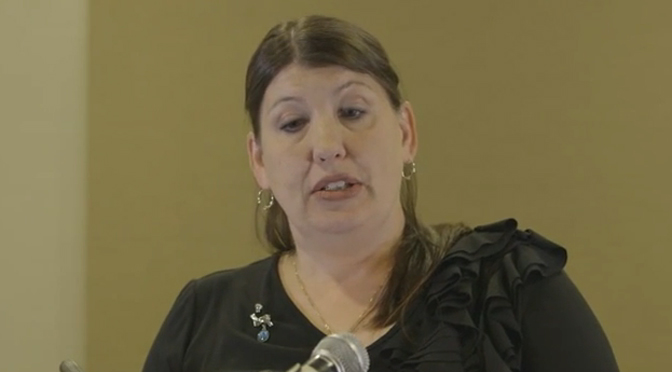A recent article in The Federalist about the pro-life organization And Then There Were None features quotes from a former abortion worker named Annette Lancaster. And Then There Were None, which was founded by former Planned Parenthood director Abby Johnson, reaches out to abortion workers and encourages them to leave the industry. The group provides healing retreats and camaraderie to workers who leave. After interviewing Lancaster, who worked at Planned Parenthood, the author of the article states:
The culture at the Planned Parenthood that employed Lancaster was as caustic and unprofessional as it was gory and ghoulish. She said it wasn’t uncommon for colleagues to mock a patient anxiously awaiting abortion.
Lancaster recalls that some abortion workers mistreated patients. She is not the only former abortion worker to make this claim.

Abby Johnson
While working at the largest Planned Parenthood facility in Texas, Abby Johnson saw women coming in for abortions every day. She comments on how these women were treated:
Although abortion advocates are constantly spouting slogans declaring their unwavering love and devotion to women, in reality, it is commonplace for some clinic workers to ignore, marginalize, blame, and ridicule the women who trust them – especially those who become confrontational when dissatisfied with services rendered by the clinic.
It would be wrong, of course, to assume that all abortion workers are hostile to women who come in for abortions. Some workers take jobs at abortion facilities because they want to help women. But committing and assisting in abortions every day takes an emotional toll on everyone involved.
In a recent Live Action article, former abortion worker Jewels Green described emptying the jars that collected fetal tissue, and counting the body parts, saying, “It looked like an oversized glass pickle jar. It was emptied next to me on the countertop: teeny tiny hands and feet and arms and legs and a rib cage and a spine and a hollow, flattened, misshapen, torn head.”

Catherine Adair, via LifeNews.com
Another former Planned Parenthood worker, Catherine Adair, says:
I was a medical assistant in the room for hundreds of abortions. I witnessed the baby being suctioned out of the uterus and watched blood and tissue work its way through the tube into a metal bowl.
The baby was dismembered during the process. The nurse would account for the baby parts and put it into a baggy, which I then put in a box with the other aborted babies. We then had to count them at the end of the day to ensure we had all of them to go to the lab.
When I saw a second trimester abortion, I saw dismembered arms and legs, with perfect feet and hands.
Unsurprisingly, seeing mutilated babies every day sometimes causes callousness in the workers. It can lead to resentment towards women having abortions.
One abortion worker, interviewed by pro-choice author Magda Denes, says that after handing the bodies of aborted babies, “I didn’t get rude or nasty with the girls, but it was a form of hostility that could be sensed. I would have an attitude.” The pressure of work coupled with the emotional fallout of seeing dismembered body parts caused this abortion worker to have a negative reaction to her patients.
Recalling her time in the abortion business, former abortion worker Dina Madsen stated, “I have to admit, though, I didn’t really have much sympathy for them [the women]. In my view, well, you got yourself into this position, tough it out.”
Pro-choice author Wendy Simonds quotes a woman complaining about the callousness of staff in an abortion facility where she worked:
I quit my job at the clinic to write my dissertation but also because I had enough of the clinic. I didn’t consider it to be a feminist place.
While the clients got adequate medical care and the counselors were solicitous, I thought the staff, in general was overly directive, paternalistic, and even callous at times.
Simonds also quotes Ann, a supervisor at an abortion facility, who discusses an abortion she received at a different facility:
[The] people [at the clinic] really didn’t care about your emotional setting. They didn’t care what happened a week after that. You know, you read the forms, you have your abortion, you leave. And I mean, there was no personal – there was no one there to listen to me… There was no support before, during, or after the procedure. I thought I was having a possible complication about three days later; there was no one to call. The office was closed. You know, and then me trying to keep it away from certain family members, and then not being able to do that because I thought I was having a medical emergency. I mean, there was no one to tell me, “This is nothing to worry about. This is normal. This is what you need to do.” … It’s an alone feeling.
Being a woman, and having to make that decision at that particular point in my life, it was already making me feel alone. And then to get to this place where I needed support or where I could possibly talk about it – because you can’t talk about it too many places and be accepted – the place that I went to, there was nothing. You couldn’t talk about it there either.
It is obvious that the abortion workers at this facility did not care about Ann’s well-being.
READ: Abortion worker: We endangered patients and never called ambulances
Other women who had abortions describe similar situations. Leah, 22, who says she is still pro-choice, makes the following statement about her abortion:
[The abortion] still was a terrible experience.… The biggest thing was just the horror of it; I’d be so scared [if I had another abortion]… [to] go to that terrible hospital and have those sterile, terrible nurses and doctors looking down on me, just like I was in a production line with all those other women; that would be scary for me to have to go through that again…
Susan M Stanford–Rue wrote about the callousness of an abortion nurse in her book, “Will I Cry Tomorrow? Healing Post–Abortion Trauma”:
I glanced at the nurse’s face as we walked down the silent corridor. She looked bored, or sullen, evidently not interested in carrying on any conversation… I could not help feeling that I was suddenly just a number, part of a routine.

Sometimes abortion workers say things about their patients that reveal contempt for them. Abortion worker Martha Mueller, who worked at a Planned Parenthood facility in Brooklyn, showed a lack of concern for patients who claimed they were being pressured into abortions. She said:
Some think that the legalization of abortion has opened a Pandora’s Box of faulty decision making. When abortion was illegal, here was a common enemy in the form of the law. Now that abortion is primarily a matter of choice, the decision rests entirely on the shoulders of the woman, a decision many would rather not have to make. Some blame their husbands or boyfriends for “forcing” them to have the abortion. Others point their anger at parents, who have insisted on the abortion or who, the patients maintain, would be furious if they found out their daughter was pregnant. “He did it to me” is a phrase heard often in the clinic or hospital corridors when the doctor walks by. That’s moving the responsibility. Women are very good at that.
A facility owner and administrator of two abortion facilities said the following about her abortion patients:
Most of them don’t think [they] can take care of a child or another child or [are] not mentally able at this time to take care of a child. Some are not the brightest light bulb. They’re really kind of “blank.”
Darla Patterson, another abortion worker, made these observations about patients on the website, “Tales from the Clinic”:
People who are lost often call us on their crap reception cellular phones and shout frantically through the mouthpiece at us the names of the streets they’re passing. They don’t want to stop and ask for directions in case people figure out where they’re going or because they’re just so tweaked out about it all that they can’t behave rationally. The fact that a good number of women are cloak-and-dagger furtive about their abortions can be somewhat tirtesome (sic) in these sort of situations, even though it’s understandable. I imagine that if I could watch their cars from a spaceship hovering above they would look like drunken bees careening around and around the hive of our clinic. Or the anti-hive, more precisely.
Patterson also says:
The thing people most obviously lie about when they come in for an abortion is about their drug usage. It’s always funny to look at somebody’s chart and see that they claimed to have “tried some crack” three weeks before. Like it was casually offered at a party after they turned down the wine. There are the Eddie Haskell types who deny any usage until they have to sign a couple of consent forms with the word “death” listed as a complication. Some people act like they’re little Pollyannas, happily sniffing flowers that have been laced with narcotics without their knowledge. “My friend gave me a joint but it had a little sumpin’ sumpin’ (sic) in it,” this woman told me last week, trying to do her best impression of an ingenue. Due to her indecent attire and heavy-handed application of her make-up she looked more like she was doing a bad impression of some teen idol musician/actor doing a bad impression of an innocent teen in a Lifetime movie.
These comments reveal a negative, jaded attitude towards patients.
Abortion facilities are not safe havens for women. They are not dedicated to empowering women. The abortion industry makes its money by exploiting women, and workers sometimes treat their patients in callous, disrespectful ways.







